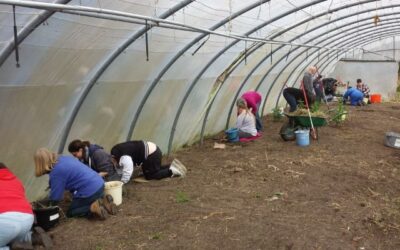Characteristics
- Successful and innovative smallholding.
- Crofting and business background: traditional values.
- Community is placed at the heart of everything.
- Carefully planned business model.
- Lots of volunteer, educational, fun activities.
- Social aspect does not contribute directly to farm income.
- Community facing activity adds to sales in local markets.
This case study is a goat farm, which has been running 12 years, starting with sheep, and now with 9 years breeding meat goats. The family have a crofting background stretching for many, many years however worked away in careers elsewhere, and then returned, setting up in Speyside rather than the original west coast. The return to farming was a lifestyle choice to some extent, “small farms do not make money rearing sheep”, so speciality hogget, mutton and goat were chosen as high value products. They had to look abroad for the depth of knowledge needed to rear meat goats – for example goats are inquisitive and their curiosity can cause stress on long journeys so extra care needs to be taken in travelling to the abattoir to prevent meat tainting, and then if carcasses are cooled too quickly, due to the low fat content (1%) cold shortening can occur giving tough meat.
The decision to target the high-quality end of the market had to be matched by a quality product. Goat meat is a healthy, protein rich food, low in cholesterol and high in nutrients. The 2019 Great Taste awards had over 12000 entries, and Elchies achieved the only three-star rating for meat producers in Scotland: one of the judges said, “you can tell this animal has been loved”. This is something that has been forgotten in modern food production.
In the early days they held an open day for local farmers to meet the animals and understand how goat rearing compared to more conventional livestock. This was well attended, and the business-model was eye-opening for some.
There was an early realisation that they were not an industrialised food production site, so it was possible to open the doors. Communication was there from the start to persuade people that the meat was good. One day the local choir made a visit and they saw the farm experience was rewarding for the visitor. The following year this evolved into an open day with a petting pen. The social media posts went viral receiving over 15000 likes, and the outcome was over £2500 raised for charity and a lot of new customers – “and we thought this is the way to show people our product and the door is open”.
Next someone said it would be great if we could bring some schoolkids here. That evolved into the following activities:
• The farm visits local schools.
• Schools visit the farm, including structured learning experiences running from six weeks up to single terms. For this they had to design various learning experiences. For example:
• A 6-week course for schools for challenging pupils. Converting the farm experience into mathematics biology, history. How do you calculate how much to feed the kid? More important is ‘how do you interact with this animal?’
• Work experience for schoolkids for whom school might be a challenging experience but want to learn the occupation. They are contributing to the working on the farm.
• Kidding Around Open day an Leaf Open Farm Sunday bringing up to 1600 visitors twice a year
• Visiting tourists – for example knitting tours from USA who are passionate to buy large amounts of local yarns and fibre product from our animals
• Volunteers who work on the farm
“It’s a memorable experience. Put someone. Anyone. with a baby kid and they will be enthralled – it triggers the imagination, something in the mind at another level, it does something to you”
The farm does not charge for any of these services – they are all free, but they get good PR and build relationships with a growing body of customers – and as a result sell more meat. It’s a deliberate decision to provide access to the business. Children and adults alike get interested and want to visit the farm.
They also have volunteers who come regularly and enjoy the chance for physical activity in the countryside, and they contribute to the farm, doing things in a collective way. There is wellbeing in learning and fixing a fence. It’s a help, and it’s a different conversation. A big bowl of soup at lunch and it’s a great social experience.
“it’s been a journey, what crofting teaches you is how to be resilient and a whole bunch of skillsets, you had to be clever to survive”
Find out more about Elchies, Simply Speyside here.




